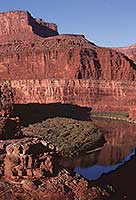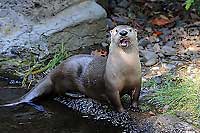 River otters, those seemingly playful creatures that can’t decide if they are aquatic or terrestrial, were never abundant in the Colorado and Green Rivers in southern Utah. Historically, from 1540 to 1872 only one expedition in the region reported otters. Of course, these groups were looking for safe passage or beavers whose pelts formed the foundation of a trapping nation. Even Peter Skene Ogden, an experienced trapper with the Hudson Bay Company and Northwest Fur Company barely reported otters in the Utah. And Ogden, the leader of the Snake River Country Expedition in 1826 who was instructed to create a “fur desert” in the West, had little to say about otters.
River otters, those seemingly playful creatures that can’t decide if they are aquatic or terrestrial, were never abundant in the Colorado and Green Rivers in southern Utah. Historically, from 1540 to 1872 only one expedition in the region reported otters. Of course, these groups were looking for safe passage or beavers whose pelts formed the foundation of a trapping nation. Even Peter Skene Ogden, an experienced trapper with the Hudson Bay Company and Northwest Fur Company barely reported otters in the Utah. And Ogden, the leader of the Snake River Country Expedition in 1826 who was instructed to create a “fur desert” in the West, had little to say about otters.
Hard to trap, they could have been overlooked. But even in the 1980’s, sightings of river otters in these major rivers or their tributaries was a cause for celebration. In the 1970’s, the Colorado Division of Wildlife released otters in the Colorado River above the state line. The Utah Division of Wildlife released otters starting in 1989 through 1992 in the Green River. It took some time, but eventually these otters found their way to the Colorado River above Moab.
 If there was an award for Most Playful Mammal, river otters would high on that list. Semi-aquatic, this member of the Mustelid family is an active, engaging creature on both land and in the water. Related to weasels, skunks, badgers and wolverines, these creatures are the most aquatic of all their relatives. An otter’s head and tail taper into a streamlined body that enhances their aquatic ability and their webbed feet are designed for propulsion while swimming. Twisting, turning, rolling underwater, otters seem well suited for the watery home.
If there was an award for Most Playful Mammal, river otters would high on that list. Semi-aquatic, this member of the Mustelid family is an active, engaging creature on both land and in the water. Related to weasels, skunks, badgers and wolverines, these creatures are the most aquatic of all their relatives. An otter’s head and tail taper into a streamlined body that enhances their aquatic ability and their webbed feet are designed for propulsion while swimming. Twisting, turning, rolling underwater, otters seem well suited for the watery home.
But otters don’t spend their entire time in the water. Their sleek and thick fur insulates them in the water, but don’t seem surprised if you ever catch an otter sliding on the ice.
Adult otters are 3-4 ½ feet long and possess a heavily muscled tail that represents about 1/3 of that length. Otters use these long tails like rudders while swimming or when sliding down an embankment or a snow bank. “Otter slides” on a muddy riverbank are one sign to search for when looking for otters. Tracks showing the webbed foot also indicate their presence; beavers have a more bowlegged gait and a large hind foot that is webbed.
 Other signs to look for include latrine sites or tracks. Otters tend to poop in a certain location on riverbanks and these scats full of fish scales, crayfish parts or bird wings are good indicators of their diets. Though “fisher folk” by nature, otters eat crustaceans, crayfish, water birds, toads, young muskrats or beavers or even small rodents while they are cruising on land. Their long, highly sensitive whiskers aid them in finding and capturing prey in murky water. A third eyelid, called a nictating membrane, protects the otter’s eye while underwater while providing some visibility.
Other signs to look for include latrine sites or tracks. Otters tend to poop in a certain location on riverbanks and these scats full of fish scales, crayfish parts or bird wings are good indicators of their diets. Though “fisher folk” by nature, otters eat crustaceans, crayfish, water birds, toads, young muskrats or beavers or even small rodents while they are cruising on land. Their long, highly sensitive whiskers aid them in finding and capturing prey in murky water. A third eyelid, called a nictating membrane, protects the otter’s eye while underwater while providing some visibility.
Mainly aquatic, otters have short, powerful legs that help them gallop overland to reach new territories or to traverse around impoundments. On land, they’ve been clocked at 18 mph and would be tough to catch on foot. Today, chances of seeing an otter in the Colorado River or one of its tributaries is much higher today than 100 years ago. Even better than Peter Skene Ogden’s, mountain man that he was.